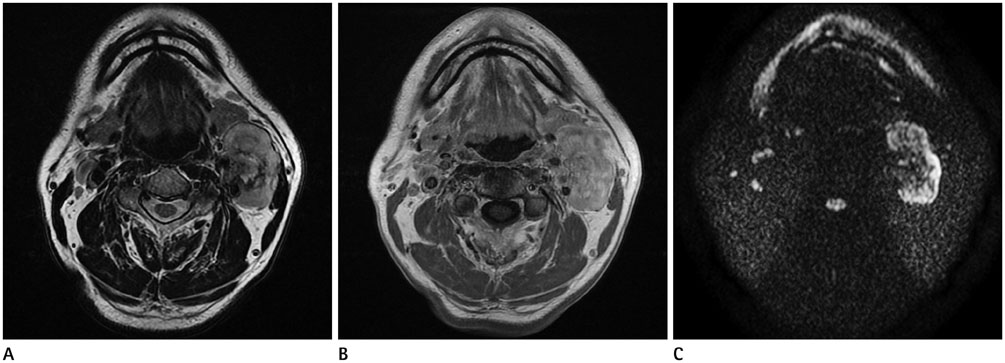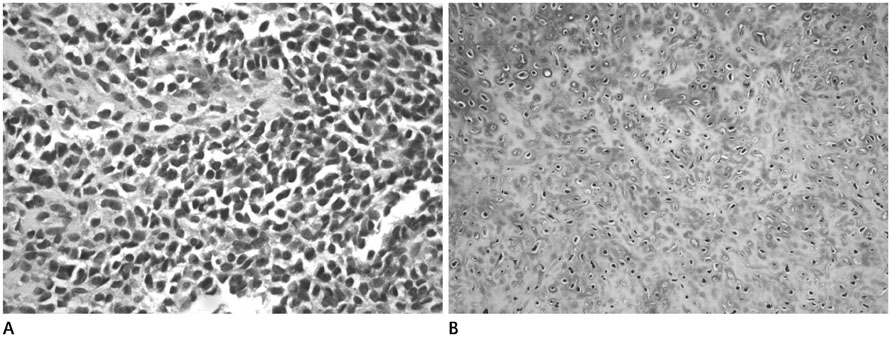J Korean Soc Radiol.
2015 May;72(5):324-328. 10.3348/jksr.2015.72.5.324.
Extraskeletal Mesenchymal Chondrosarcoma of the Carotid Space: A Case Report
- Affiliations
-
- 1Department of Radiology, Bucheon Hospital, Soonchunhyang University College of Medicine, Bucheon, Korea. hshong@schmc.ac.kr
- 2Department of Pathology, Bucheon Hospital, Soonchunhyang University College of Medicine, Bucheon, Korea.
- KMID: 1793888
- DOI: http://doi.org/10.3348/jksr.2015.72.5.324
Abstract
- Chondrosarcoma is a commonly encountered malignant cartilaginous tumor. However, only 1% of chondrosarcomas arise in the extraskeletal region. The pathologic types of this tumor include mesenchymal, myxoid, and low grade. A mesenchymal chondrosarcoma is a rare, highly malignant cartilaginous tumor that is rarely encountered, and it shows similar imaging features to other malignant soft-tissue tumors. Here, we report a mesenchymal chondrosarcoma presenting as a palpable mass in the neck, arising in the carotid space, which is also known as the retrostyloid parapharyngeal space.
Figure
Reference
-
1. Shapeero LG, Vanel D, Couanet D, Contesso G, Ackerman LV. Extraskeletal mesenchymal chondrosarcoma. Radiology. 1993; 186:819–826.2. Lightenstein L, Bernstein D. Unusual benign and malignant chondroid tumors of bone. A survey of some mesenchymal cartilage tumors and malignant chondroblastic tumors, including a few multicentric ones, as well as many atypical benign chondroblastomas and chondromyxoid fibromas. Cancer. 1959; 12:1142–1157.3. Nakashima Y, Unni KK, Shives TC, Swee RG, Dahlin DC. Mesenchymal chondrosarcoma of bone and soft tissue. A review of 111 cases. Cancer. 1986; 57:2444–2453.4. Bahr AL, Gayler BW. Cranial chondrosarcomas. Report of four cases and review of the literature. Radiology. 1977; 124:151–156.5. Mafee MF, Valbasson GE, Becker M. Imaging of the Head and Neck. Stuttgart: Georg Thieme Verlag;2012. p. 602–608.6. Som PM, Curtin HD. Head and Neck Imaging. Boston: Elsevier Health Sciences;2011. p. 1749–1779.7. Murphey MD, Walker EA, Wilson AJ, Kransdorf MJ, Temple HT, Gannon FH. From the archives of the AFIP: imaging of primary chondrosarcoma: radiologic-pathologic correlation. Radiographics. 2003; 23:1245–1278.8. Hashimoto N, Ueda T, Joyama S, Araki N, Beppu Y, Tatezaki S, et al. Extraskeletal mesenchymal chondrosarcoma: an imaging review of ten new patients. Skeletal Radiol. 2005; 34:785–792.9. Huvos AG, Rosen G, Dabska M, Marcove RC. Mesenchymal chondrosarcoma. A clinicopathologic analysis of 35 patients with emphasis on treatment. Cancer. 1983; 51:1230–1237.10. Banks KP, Ly JQ, Thompson LD, Michaelson PG, Davis SW. Mesenchymal chondrosarcoma of sinonasal cavity: a case report and brief literature review. Eur J Radiol Extra. 2004; 49:47–51.
- Full Text Links
- Actions
-
Cited
- CITED
-
- Close
- Share
- Similar articles
-
- A Case of Postoperative Chemotherapy of Extraskeletal Mesenchymal Chondrosarcoma
- Extraskeletal Mesenchymal Chondrosarcoma of the Mediastinum: A Case Report
- A Case Report of Extraskeletal Chondrosarcoma
- Fine Needle Aspiration Cytology of Extraskeletal Mesenchymal Chondrosarcoma
- A Case of Mesenchymal Chondrosarcoma In Pancreas




